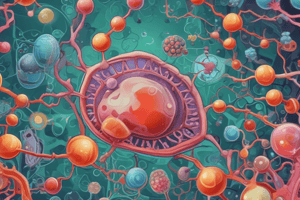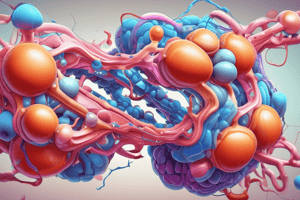Podcast
Questions and Answers
Which of the following is NOT a primary role of biological membranes?
Which of the following is NOT a primary role of biological membranes?
- Selective permeability for enzyme systems
- Physical and chemical compartmentation
- Regulation of immune responses
- Direct ATP synthesis (correct)
Which lipid is predominantly located in the plasma membrane?
Which lipid is predominantly located in the plasma membrane?
- Phosphatidylinositol
- Cardiolipin
- Cholesterol (correct)
- Phosphatidylserine
Which of the following is a characteristic of integral membrane proteins?
Which of the following is a characteristic of integral membrane proteins?
- They can only be removed by destroying the membrane structure. (correct)
- They are typically glycosylated in the cytosol.
- They are easily removed without disrupting the membrane.
- They interact with membranes via hydrogen bonding.
What contributes to the asymmetric distribution of lipids in the plasma membrane?
What contributes to the asymmetric distribution of lipids in the plasma membrane?
Which statement best describes the effect of cholesterol on membrane fluidity at physiological temperatures?
Which statement best describes the effect of cholesterol on membrane fluidity at physiological temperatures?
Why is transverse diffusion of lipids in a membrane energetically unfavorable?
Why is transverse diffusion of lipids in a membrane energetically unfavorable?
Which of the following molecules would most likely cross a cell membrane via simple diffusion?
Which of the following molecules would most likely cross a cell membrane via simple diffusion?
How does facilitated diffusion differ from simple diffusion?
How does facilitated diffusion differ from simple diffusion?
Which statement accurately describes the kinetic properties of facilitated diffusion?
Which statement accurately describes the kinetic properties of facilitated diffusion?
Which of the following is an example of a symporter?
Which of the following is an example of a symporter?
What is a key difference between active transport and facilitated diffusion?
What is a key difference between active transport and facilitated diffusion?
What is the primary function of the Na+/K+ ATPase pump?
What is the primary function of the Na+/K+ ATPase pump?
How do hormones influence cellular metabolism?
How do hormones influence cellular metabolism?
What is a common characteristic of plasma membrane receptors?
What is a common characteristic of plasma membrane receptors?
How does hormone binding affect plasma membrane receptors?
How does hormone binding affect plasma membrane receptors?
What determines the concentration of cAMP in a cell?
What determines the concentration of cAMP in a cell?
What is the role of protein kinase A (PKA) in intracellular signaling?
What is the role of protein kinase A (PKA) in intracellular signaling?
How do epinephrine and glucagon influence intracellular signaling pathways?
How do epinephrine and glucagon influence intracellular signaling pathways?
What function does the GTPase activity of G-proteins serve?
What function does the GTPase activity of G-proteins serve?
What is the mechanism behind desensitization to epinephrine?
What is the mechanism behind desensitization to epinephrine?
Which enzyme is stimulated by hormones such as angiotensin II and vasopressin?
Which enzyme is stimulated by hormones such as angiotensin II and vasopressin?
What two messenger molecules are produced by the action of phospholipase C?
What two messenger molecules are produced by the action of phospholipase C?
What is the role of inositol 1,4,5-trisphosphate (IP3) in the phosphoinositide cascade?
What is the role of inositol 1,4,5-trisphosphate (IP3) in the phosphoinositide cascade?
How does diacylglycerol (DAG) activate protein kinase C (PKC)?
How does diacylglycerol (DAG) activate protein kinase C (PKC)?
What catalytic activity is associated with the intracellular domain of tyrosine kinase receptors?
What catalytic activity is associated with the intracellular domain of tyrosine kinase receptors?
What is the initial step in insulin signaling after insulin binds to its receptor?
What is the initial step in insulin signaling after insulin binds to its receptor?
Which of the following is a long-term effect of insulin signaling?
Which of the following is a long-term effect of insulin signaling?
How is the insulin signal terminated?
How is the insulin signal terminated?
What is the role of nitric oxide (NO) in vascular endothelial cells?
What is the role of nitric oxide (NO) in vascular endothelial cells?
What is the effect of increased cGMP levels in smooth muscle cells?
What is the effect of increased cGMP levels in smooth muscle cells?
Which of the following best describes the function of cytosolic receptors?
Which of the following best describes the function of cytosolic receptors?
What is the effect of cholera toxin on Gs alpha subunit activity?
What is the effect of cholera toxin on Gs alpha subunit activity?
How is the NO production associated with smooth muscle relaxation and inflow of blood to the corpus cavernosum enhanced in the treatment of erectile dysfunction?
How is the NO production associated with smooth muscle relaxation and inflow of blood to the corpus cavernosum enhanced in the treatment of erectile dysfunction?
Which bacterial toxin inhibits the G1 alpha subunit?
Which bacterial toxin inhibits the G1 alpha subunit?
The ras oncogene is a G-protein. What is the cause of a constitutively active form?
The ras oncogene is a G-protein. What is the cause of a constitutively active form?
What directly stimulates by the release of fatty acids and calcium from phospholipase C?
What directly stimulates by the release of fatty acids and calcium from phospholipase C?
What is the function of ATP in activating a protein?
What is the function of ATP in activating a protein?
Flashcards
Membrane Composition
Membrane Composition
Lipids, proteins, and carbohydrates determine membrane function; selective permeability allows compartmentation.
Membrane Lipids
Membrane Lipids
Phospholipids, sphingolipids, and cholesterol. Distribution is asymmetric.
Integral Membrane Proteins
Integral Membrane Proteins
Penetrate or interface with the membrane; removed by detergents/solvents.
Peripheral Membrane Proteins
Peripheral Membrane Proteins
Signup and view all the flashcards
Membrane Carbohydrates
Membrane Carbohydrates
Signup and view all the flashcards
Membrane Fluidity
Membrane Fluidity
Signup and view all the flashcards
Simple Diffusion
Simple Diffusion
Signup and view all the flashcards
Facilitated Diffusion
Facilitated Diffusion
Signup and view all the flashcards
Types of Facilitated Diffusion
Types of Facilitated Diffusion
Signup and view all the flashcards
Active Transport
Active Transport
Signup and view all the flashcards
Hormones
Hormones
Signup and view all the flashcards
Plasma Membrane Receptors
Plasma Membrane Receptors
Signup and view all the flashcards
Cyclic AMP System
Cyclic AMP System
Signup and view all the flashcards
G-Protein Activation
G-Protein Activation
Signup and view all the flashcards
Desensitization
Desensitization
Signup and view all the flashcards
Phosphoinositide Cascade
Phosphoinositide Cascade
Signup and view all the flashcards
Inositol Trisphosphate (IP3)
Inositol Trisphosphate (IP3)
Signup and view all the flashcards
Diacylglycerol (DAG)
Diacylglycerol (DAG)
Signup and view all the flashcards
Tyrosine Kinase Receptors
Tyrosine Kinase Receptors
Signup and view all the flashcards
Insulin Receptor
Insulin Receptor
Signup and view all the flashcards
Nitric Oxide (NO)
Nitric Oxide (NO)
Signup and view all the flashcards
Intracellular Receptors
Intracellular Receptors
Signup and view all the flashcards
Cholera Toxin Action
Cholera Toxin Action
Signup and view all the flashcards
Erectile Dysfunction
Erectile Dysfunction
Signup and view all the flashcards
Study Notes
Membrane Structure and Composition
- Membranes are composed of lipids, proteins, and carbohydrates
- These components dictate several biologic functions such as cell signaling and transport
- Selective permeability supports physical and chemical compartmentalization of intracellular enzyme systems
- Membranes contain enzymes and receptors that allow cells to respond to external signals and generate chemical and electrical signals
- Permeability is controlled by molecular channels and pumps
- External surface composition determines cell-to-cell recognition processes involved in cell adhesion and immune responses
Membrane Components
- Lipids include phospholipids, sphingolipids, and cholesterol
- Phospholipids contain two fatty acids attached to glycerol in addition to a phosphate group
- Fatty acids can be saturated or unsaturated
- Most phospholipids have ethanolamine, choline, inositol, or serine esterified to the phosphate
- Sphingolipids include sphingomyelin, cerebrosides, and gangliosides
- Cerebrosides and gangliosides are sugar-containing lipids primarily in the plasma membrane
- Sphingomyelin is prominent in myelin sheaths
- Cholesterol is in the plasma membrane, with its hydroxyl group on the surface at the water interface
- Membranes are generally 40-50% protein, but can range from 20% in the myelin membrane to 80% in the inner mitochondrial membrane
- Protein and lipid composition is unique for each membrane, and distribution is asymmetric
Integral Membrane Proteins
- Integral membrane proteins may penetrate the membrane or exist as transmembrane proteins interfacing with both the cytosol and external environment
- They interact strongly with membrane lipids through hydrophobic side chains, removable only by destroying membrane structure
- They are usually composed of multiple α-helices with hydrophobic side chains
- Cylindrical arrays form pores for transport of polar molecules
Peripheral Membrane Proteins
- Peripheral membrane proteins are loosely associated with the surface of either side of the membrane
- They interact with the membrane through hydrogen bonding or salt-bridging
- They can be removed without disrupting the structure of the membrane
- Membrane carbohydrates exist only as extracellular covalent attachments to lipids and proteins
- Carbohydrate structures are highly variable and may be highly antigenic, contributing to the immune recognition of cells
Membrane Structure
- Membranes selectively separate internal and external aqueous compartments using a phospholipid bilayer
- The bilayer consists of two monolayers (leaflets) of phospholipids
- Hydrophilic phosphate head groups face the aqueous solution
- Hydrophobic fatty acid tails face the center of the bilayer
- Bilayers form sheetlike structures measuring 60-100 Å in thickness, held together by noncovalent forces
- Although the bilayer is symmetric regarding amphipathic lipid orientation, the composition is asymmetric
- Exterior monolayer: contains mostly sphingomyelin and phosphatidylcholine
- Interior monolayer: contains mostly phosphatidylserine and phosphatidylethanolamine
- Cholesterol is more evenly distributed, with composition determined by membrane function
- Membrane proteins are distributed asymmetrically to localize enzyme activity, energy transduction, facilitated transport, and receptors
- Peripheral proteins may contain a lipid anchor extending into the membrane
- Membrane composition and asymmetry are maintained by adding new membrane structure to existing structure
- Self-assembly permits self-sealing of damage to the phospholipid bilayer
Fluid Properties of Membranes
- The assembly of proteins and lipids into a membrane creates a fluid mosaic
- Both proteins and lipids undergo two-dimensional lateral diffusion in the membrane
- Transverse diffusion is energetically unfavorable, proteins and lipids do not "flip-flop" without flippase enzymes
- Fluidity is affected by factors:
- Long-chain saturated fatty acids: Interact strongly and reduce fluidity
- Double bonds: Increase fluidity, greater with cis-configuration than with trans-configuration
- Cholesterol: Prevents movement of fatty acid chains and reduces fluidity
- Temperature: Fluidity increases with temperature
Membrane Transport
- Membranes block hydrophilic molecules and restrict diffusion through the lipid bilayer
- Movement across the membrane is governed by simple diffusion, facilitated diffusion, and active transport
Simple Diffusion
- Water, gases (O2, CO2, NO), and lipophilic molecules cross membranes
- It occurs down a concentration gradient in either direction
- A steep concentration gradient produces faster diffusion compared to a shallow gradient
- Smaller molecules diffuse faster than larger molecules
- Simple diffusion is not saturable; the rate increases linearly with the increase in substrate concentration gradient
Facilitated Diffusion
- When molecules are excluded from simple diffusion due to size or charge, facilitated diffusion mechanisms exist
- Specialized carrier proteins in the membrane either diffuse across the membrane with their substrate or extend across the membrane, forming a channel
- Similarities to simple diffusion:
- Diffusion occurs down a concentration gradient
- Energy is supplied by the gradient, not cellular energy
- Differences from simple diffusion:
- Facilitated diffusion is faster than simple diffusion
- The carrier has specificity for the transported substance
- Facilitated diffusion displays saturation kinetics
- Carrier proteins such as translocases, porters, and permeases show:
- Structural specificity for transported molecules
- Dissociation constant (Tm) for the transported molecule, analogous to Km for enzymes
- Inhibition by agents that block the transport of specific molecules
- Exhibited saturation kinetics (Vmax)
- Facilitated diffusion has three primary modes:
- Ion channels: protein-lined channels that selectively allow ions to flow at a high rate when they are open
- Formed by multiple transmembrane domains of the specific ion channel protein
- Some channels are gated and open transiently in response to specific signals
- Uniporters: facilitate diffusion of single substances, such as glucose or a specific amino acid
- GLUT family of sodium-independent glucose transporters passively transport glucose, galactose, and fructose into most cells
- Cotransporters: transport more than one molecule simultaneously
- Symporters: carry two different molecules in the same direction at the same time
- Antiporters: carry two different molecules in opposite directions at the same time
- Ion channels: protein-lined channels that selectively allow ions to flow at a high rate when they are open
- Example of symporter: Glucose transporter in the kidney and intestine
- Example of antiporter: Chloride-bicarbonate transporter in erythrocyte membranes
Active Transport
- Carrier proteins transport molecules against a gradient
- Can be directly coupled to hydrolysis of ATP
- Specific for the molecules being transported
- Demonstrates saturation kinetics
- Can be specifically inhibited
- No ATP hydrolysis without transport
- Example of active transport is the sodium/potassium ATPase antiporter
- Maintains low intracellular Na+ and high intracellular K+
- Pumps 3 Na+ out and 2 K+ in for every ATP hydrolyzed
Intracellular Signal Transduction
- Hormones are physiologic signals that influence cellular metabolism by triggering coordinated intracellular responses
- The signal travels from the hormone molecule to the change in activity of the target enzymes
- It is transmitted through a signal transduction cascade
- Since each reaction step in the cascade produces a catalyst as its product, each step serves to amplify the signal
Plasma Membrane Receptors
- Plasma membrane receptors are transmembrane proteins that generate an intracellular response following binding of hormones, cytokines, or other signals on the exterior
- They share several characteristics with enzymes:
- Hormone binding induces a conformational change in the receptor protein
- Hormone binding demonstrates reversibility
- Hormone binding demonstrates inhibition
- The response to a given hormone can be positive or negative depending on which receptors are present
Cyclic Adenosine Monophosphate System
- When epinephrine and glucagon bind to their receptors, they send a wave of phosphorylation through the cell that leads to coordinated changes in metabolism
- The initial signal that is generated in this pathway is the second messenger molecule, cyclic adenosine monophosphate (cAMP)
- cAMP is synthesized by a membrane-bound adenylate cyclase when the hormone binds to the receptor
- Cyclic AMP concentration is determined by the balance between adenylate cyclase and cAMP phosphodiesterase activity
- Increased concentration of cAMP converts more protein kinase A to its active form
- Protein kinase A regulates a variety of target proteins and enzymes by phosphorylation with ATP
G-Protein-Mediated Signal Transduction
- Epinephrine and glucagon receptors activate a G-protein complex that interacts with adenylate cyclase
- G-protein-coupled receptors contain seven a-helical domains extending across the membrane
- Hormone binding causes a change in intracellular domain, allowing interaction with the heterotrimeric Gs protein
- The α-subunit of the Gs protein releases bound GDP and binds GTP
- The α-subunit-GTP complex dissociates from the β-γ dimer and interacts with adenylate cyclase
- Binding one hormone molecule causes the formation of several subunits; this amplifies he hormonal signal
- The α-subunit deactivates itself within minutes by hydrolyzing GTP to GDP GTPase activity; the GDP remains bound
- The α-subunit-GDP complex reassociates with the β-γ dimer to form an inactive complex
- Spontaneous GTP hydrolysis gives G-proteins an automatic deactivating mechanism
Desensitization to Epinephrine
- The epinephrine receptor undergoes accommodation to unchanging concentrations of epinephrine
- As the Gs subunits dissociate from the receptor, the β-adrenergic receptor kinase phosphorylates the cytoplasmic domain of the receptor
- The phosphorylated domain will not interact with G protein even with epinephrine bound to the receptor
- The kinase phosphorylates only the hormone-receptor complex
- Epinephrine levels must increase to generate a new active hormone-receptor complex
Phosphoinositide Cascade
- Some hormones such as angiotensin II, epinephrine (α1-receptors), vasopressin, and oxytocin stimulate the action of phospholipase C in the plasma membrane
- Phospholipase C hydrolyzes phosphatidylinositol 4,5-bisphosphate (PIP2) to produce inositol 1,4,5-trisphosphate (IP3) and diacylglycerol (DAG)
- IP3 causes a rapid release of Ca++ from the endoplasmic reticulum by opening Ca++ channels
- Cytosolic Ca++ then binds to calmodulin
- The Ca++-calmodulin complex then activates Ca++-calmodulin-dependent protein kinases
- The Ca++-calmodulin complex also activates a Ca++-ATPase pump, quickly restoring low intracellular [Ca++]
- Smooth muscle contraction is activated by Ca++ through this signaling mechanism
- Uncomplexed Ca++ also activates protein kinase C, which plays a role in platelet activation and prostaglandin action
- DAG increases the activity of protein kinase C by increasing its affinity for Ca++
- Protein kinase C regulates target proteins by serine and threonine phosphorylation
- The phosphoinositide-related hormones activate the Gq protein by allowing it to bind GTP
- Phosphatases degrade IP3 to inositol, and DAG is degraded to phosphatidic acid
Tyrosine Kinase Receptors
- Insulin and several other growth factors communicate their signal through tyrosine kinase receptors
- They span the plasma membrane with only one α-helix
- The intracellular domain has two types of tyrosine kinase catalytic activity:
- The receptors phosphorylate themselves (autophosphorylation)
- They phosphorylate tyrosine residues on target proteins
- Insulin receptor is a tetramer that is stabilized by internal disulfide bonds
- Upon binding insulin to the external domain, the internal tyrosine kinase domain phosphorylates tyrosine residues on insulin receptor substrate 1 (IRS-1) to transduce the insulin signal by two pathways:
- IRS-1 converts phosphatidylinositol in the plasma membrane to PIP2, leading to activation of protein kinase B
- IRS-1 converts inactive ras (another type of G-protein) into its active GTP-bound form which activates MAP kinase
- The insulin signal is terminated by endocytosis of the insulin-receptor complex in endosomes
Intracellular Receptors of Lipophilic Hormones
- Cytosolic receptors bind lipophilic hormones, such as the steroid hormones or retinoic acid
- Cytosolic receptor-hormone complexes are transported to the nucleus, where they regulate gene expression
- Their action is much slower than membrane receptor pathways, taking hours to days to reach full effect
Clinical Aspects of Intracellular Signaling
- Several bacterial toxins catalyze the covalent attachment of adenosine diphosphate (ADP)-ribose to G-proteins
- Cholera toxin ADP-ribosylates the Gs α-subunit, leading to excessive water and electrolyte secretion
- Pertussis toxin ADP-ribosylates the Gi α-subunit which produces whooping cough
- Diphtheria toxin ADP-ribosylates eEF-2, blocking polypeptide synthesis.
- Erectile Dysfunction:
- Erection of the penis involves release of NO in the corpus cavernosum as a result of sexual stimulation
- NO activates guanylate cyclase, increasing cGMP levels, producing smooth muscle relaxation in the corpus cavernosum and allowing inflow of blood
- Drugs enhance the effect of NO by inhibiting phosphodiesterase type 5
Studying That Suits You
Use AI to generate personalized quizzes and flashcards to suit your learning preferences.




